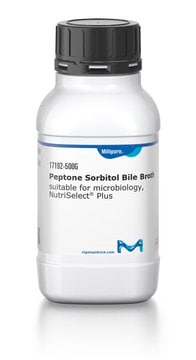18502
Oxidase Reagent according to Gordon-McLeod
suitable for microbiology
Sinónimos:
Gordon-McLeod Reagent
About This Item
Productos recomendados
Agency
according to ISO 9308-1:2014
Nivel de calidad
Línea del producto
BioChemika
caducidad
limited shelf life, expiry date on the label
composición
N,N-dimethyl-p-phenylenediamine hydrochloride, 0.15 g
water, 10 mL
envase
pkg of 100 mL
condiciones de almacenamiento
(Tightly closed)
técnicas
microbe id | specific enzyme detection: suitable
espectro de actividad antibiótica
Gram-negative bacteria
aplicaciones
clinical testing
environmental
food and beverages
pharmaceutical
microbiology
idoneidad
Plesiomonas spp.
Aeromonas spp.
Neisseria spp.
Pseudomonas spp.
bacteria
Descripción general
Aplicación
Palabra de señalización
Danger
Frases de peligro
Consejos de prudencia
Clasificaciones de peligro
Resp. Sens. 1
Código de clase de almacenamiento
10 - Combustible liquids
Clase de riesgo para el agua (WGK)
WGK 2
Punto de inflamabilidad (°F)
Not applicable
Punto de inflamabilidad (°C)
Not applicable
Equipo de protección personal
Eyeshields, Faceshields, Gloves
Elija entre una de las versiones más recientes:
¿Ya tiene este producto?
Encuentre la documentación para los productos que ha comprado recientemente en la Biblioteca de documentos.
Los clientes también vieron
Artículos
Vibrios are motile, curved or comma-shaped bacilli and have a single polar flagella with sheet proteins. They are often found in open water, freshwater and saltwater.
There are many other methods of detection to indicate the presence of E. coli. Review common tests and biochemical reactions for this contaminant.
Specific agars and broths support detection and cultivation of Campylobacter, requiring complex media with essential supplements.
Chromogenic media enable the selective detection of S. aureus, which produce bluish-green colonies that are clearly differentiated from other species.
Protocolos
General guidance for the detection and enumeration of Enterobacteriaceae in food according to EN-ISO 8523:1991 and EN-ISO 4832:1991, respectively.
Listeria is a public health concern, affecting elderly, pregnant, newborns, and immunocompromised individuals.
Nuestro equipo de científicos tiene experiencia en todas las áreas de investigación: Ciencias de la vida, Ciencia de los materiales, Síntesis química, Cromatografía, Analítica y muchas otras.
Póngase en contacto con el Servicio técnico







